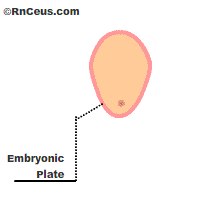Introduction
 The heart, by necessity, is one of the earliest functioning organs. As the embryonic plate approaches 400 microns in thickness, diffusion alone cannot support the metabolic requirements of the growing embryonic cell mass. Heart development must keep pace with the embryo's need for oxygen, nutrients and waste removal.
The heart, by necessity, is one of the earliest functioning organs. As the embryonic plate approaches 400 microns in thickness, diffusion alone cannot support the metabolic requirements of the growing embryonic cell mass. Heart development must keep pace with the embryo's need for oxygen, nutrients and waste removal.
As early as 15 days after conception,
precardiac cells (angioblasts) cluster in the anterior end of the developing embryo. By
day 18, these clusters form a plexus of blood vessels. Conformational changes in the embryo and extensions of the vessels create two thin walled tubes that eventually merge into one.
The first pulsations of the
primitive circulatory system start approximately 22 days after
fertilization. At this point, the embryonic heart is a tube
divided at each end. By 24 days the tube is capable of peristaltic propulsion of fluid and resembles the last frame of the animation.
Instant Feedback:
Precardiac cells cluster in the anterior end of the embryonic plate around day 15 after fertilization.
©RnCeus.com
 The heart, by necessity, is one of the earliest functioning organs. As the embryonic plate approaches 400 microns in thickness, diffusion alone cannot support the metabolic requirements of the growing embryonic cell mass. Heart development must keep pace with the embryo's need for oxygen, nutrients and waste removal.
The heart, by necessity, is one of the earliest functioning organs. As the embryonic plate approaches 400 microns in thickness, diffusion alone cannot support the metabolic requirements of the growing embryonic cell mass. Heart development must keep pace with the embryo's need for oxygen, nutrients and waste removal.